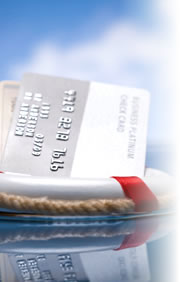Don’t let Hurricane Sandy wreak havoc with your credit cards

As Hurricane Sandy approached the east coast, a number of newspapers in the region invited readers to post pictures of their personal experiences. Many were heartbreaking: trees across cars, branches that had crashed through roofs into bedrooms, and appalling flood damage. Luckily, most of what we saw was probably covered by insurance, although some policyholders may be disappointed when they come to make claims.
In particular, according to The Washington Post of Oct. 29, many householders may be in for a shock when they try to claim for flood damage. That’s because few standard homeowner policies cover those risks. If you haven’t paid extra for flood coverage, you could be looking at paying to repair the damage and replace ruined possessions yourself. And that could be expensive: The Post reports that claims for flood damage between 2007 and 2011 averaged $30,000.
Credit cards are one way forward
Some people have set aside money for emergencies in — in this case aptly named — rainy day funds. But few are likely to contain $30,000, so it’s almost inevitable that many on the east coast are going to be borrowing to bridge some wide gaps.
If you’re lucky, you may be covered by federal disaster assistance, but be warned: that only applies if the President declares an emergency for your area, and even then the money you receive is a loan that has to be repaid — with interest. FEMA gives an example: “For a $50,000 loan at 4 percent interest, your monthly payment would be around $240 a month ($2,880 a year) for 30 years.”
That’s a pretty good rate, and you might struggle to beat the deal even with a mortgage refinancing once you’ve taken closing costs into account. Other low-rate options, perhaps for smaller amounts, might include:
- A home equity line of credit or personal loan from your bank.
- Borrowing from relatives and friends who have the means to help.
- Applying to a peer-to-peer lender such as Prosper or Lending Club.
- Using your credit cards.
Using your credit cards smartly
Obviously, your primary objective is to pay as little interest as possible, which may make plastic your least desirable option. IndexCreditCards.com reckons that, on the day Hurricane Sandy hit the continental United States, consumer credit card rates averaged 15.15 percent for non-rewards cards, and 17.64 percent for rewards credit cards.
However, you may have no alternative other than to use plastic to purchase some replacement possessions and to fund some repairs. If that’s the case, don’t be dazzled by rewards. Almost always, whatever you earn in cash back, points or miles is going to be eaten up quickly by higher interest rates.
Of course, if you know you’ll be able to zero your balance within a matter of weeks then go ahead and enjoy those rewards. For example, Discover offers card members a 5 percent cash-back bonus on up to $1,500 in categories that change each quarter, though you have to register online or through the company’s call center to be eligible.
However, if you won’t be zeroing your balance anytime soon, it’s virtually inevitable that you’d be better off using low interest credit cards. Those with the lowest rates don’t generally offer rewards, but you could save a bundle with them. For instance, on that same fateful day Hurricane Sandy came ashore, the Simmons First Visa® Platinum card, which is available only to those with excellent credit, had a variable rate of just 7.25 percent APR.
Balance transfer credit cards
One more trick you might want to pull from your sleeve is to apply for balance transfer credit cards that offer a zero-percent introductory APR. Using these, you can pay down your card debt more quickly because you can use the money that would normally have gone on interest to reduce it. However, these products need to be treated with care: that interest-free 6, 12, 15 or 18 months is going to fly by, and you must be sure you can afford payments when the card moves to its standard rate.
Balance transfer offers change notoriously quickly, and you should click that link to check what’s current by the time you read this. But, at the end of October, at least six cards were offering 15 months at zero percent APR, and a couple were giving 18 months. Most — though not quite all — charge a one-off balance transfer fee, which is usually 3 percent.
Credit cards can be our friends during difficult times such as these, but only if they’re treated with respect. If Hurricane Sandy has already wreaked havoc with your home and belongings, don’t let it continue to ruin your life through future financial hardship.
Disclaimer:The information in this article is believed to be accurate as of the date it was written. Please keep in mind that credit card offers change frequently. Therefore, we cannot guarantee the accuracy of the information in this article. Reasonable efforts are made to maintain accurate information. See the online credit card application for full terms and conditions on offers and rewards. Please verify all terms and conditions of any credit card prior to applying.
This content is not provided by any company mentioned in this article. Any opinions, analyses, reviews or recommendations expressed here are those of the author’s alone, and have not been reviewed, approved or otherwise endorsed by any such company. CardRatings.com does not review every company or every offer available on the market.
Published (Modified )